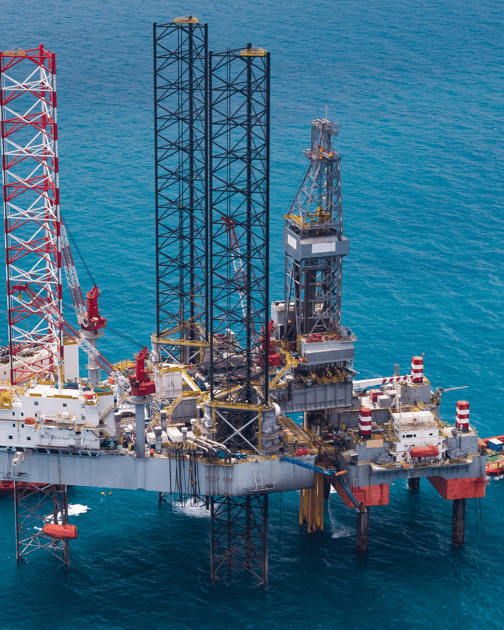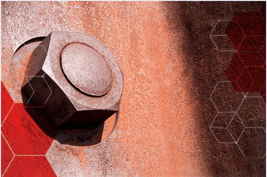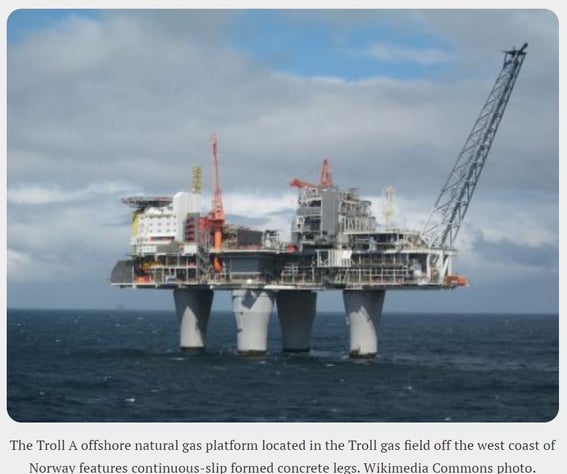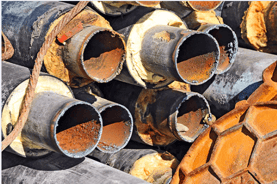Protecting Steel-Reinforced Concrete Marine Structures from Corrosion
April 28, 2023 •Corrosion CONTROLLED, Corrosion Essentials, Coatings

The major cause of deterioration on steel-reinforced concrete structures located in marine environments is corrosion of the reinforcing steel. According to NACE International member Douglas L. Leng with Vector Corrosion Technologies (Richland, Michigan, USA), this deterioration is most evident on substructure components (e.g., foundations, footers, pilings, etc.) in southern climates; however, reinforcing steel corrosion can also be present on superstructure components (e.g., bridge decks, beams, pile caps, etc.) on the coasts or in northern states where deicing salts are used. Every year, millions of dollars are spent to repair damaged concrete structures to assure their safe use.
In a symposium paper from CORROSION 2017 in New Orleans, Louisiana, USA, Leng discusses protecting concrete structures from degradation using cathodic protection (CP), the preferred method for mitigating corrosion of steel reinforcement in concrete. He notes that a wide variety of CP systems are effectively used to control corrosion on steel-reinforced concrete structures located in marine environments.
Because reinforcing steel is very compatible with concrete due to their similar coefficients of thermal expansion, steel-reinforced concrete is considered an excellent, low-cost building material. Concrete generally provides the reinforcing steel with corrosion protection due to the passive film created on the steel’s surface because of the high alkalinity of Portland cement, a key component of concrete. Leng explains that this passive film naturally protects the steel reinforcement from corrosion as long as the concrete remains in a highly alkaline state and external factors do not impart a change in this condition.
Corrosion of Reinforcing Steel
Steel has a natural tendency to return to its native state of an ore when it reacts with the environment. External factors, such as temperature, humidity, availability of oxygen, and other physical characteristics, play a major role in the rate at which steel corrodes. For reinforcing steel in concrete, there are several mechanisms that can break down the steel’s protective passive film and lead to corrosion.
Typical Portland cement concrete is very porous. When used to build structures in and near seawater, it acts like a sponge and will absorb external materials or substances, such as deicing salts, chlorides, chemicals, or other halides. These contaminants absorb into the concrete matrix by capillary action and diffusion, and they eventually reach the embedded steel reinforcement. According to Leng, studies have shown that corrosion activity and damage result when critical quantities of aggressive ions penetrate through the concrete pore structure by diffusion and other transport methods because they can break down the naturally occurring passive film when they reach the steel reinforcement in a high concentration. If corrosion of embedded steel in marine structures is left unaddressed, it can lead to catastrophic failures and public risk.
The process of chloride absorption through concrete is dictated by several factors, including exposure limits, salt concentrations, durability of the concrete, resistance of the concrete, concrete cover, and many other considerations. These factors all influence the rate of absorption and the time it takes for chlorides to exceed threshold values, Leng says, noting that determining the time it takes for chlorides to actually reach the embedded steel is somewhat of a science.
Cathodic Protection in Marine Environments
In 2001, the U.S. Federal Highway Administration (FHWA) issued a report1 that says CP is the only rehabilitation technique proven to stop corrosion in salt-contaminated concrete structures, regardless of chloride content in the concrete. CP is an electrochemical process that incorporates an anode, a cathode, a metallic path, and an electrolyte. This technology is based on the principle of applying an external source of electrical current to counteract the internal corrosion current produced in reinforced concrete components. The cathode is the steel reinforcement that needs protection against corrosion, the electrolyte is the saturated concrete, the anode is the metallic material selected to deliver the protective current, and a metallic path is the path that completes the circuit. The concept of CP, Leng says, is to transform the entire surface of the reinforcing steel into the cathode in a corrosion cell.
There are two forms of CP: impressed current CP (ICCP) and sacrificial anode CP (SACP). When properly designed, installed, and commissioned, Leng comments, both types of CP systems are successful at applying small levels of electrical current to an affected region to control corrosion. Anode types vary, and they may be installed in the form of mesh, ribbons, overlays, metallic coatings, and other suitable configurations.
ICCP uses a permanent external power source, such as a rectifier, solar cells, batteries, fuel cells, or other means, to deliver protective electrical current to the steel reinforcement. Maintaining rectifier currents and making adjustments to changing conditions is necessary to provide the correct level of corrosion protection over the service life of the anodes. ICCP systems can operate under two modes: constant current with an upper voltage limit, or constant voltage with a current limit so the steel is not overprotected, which can cause excessive hydrogen generation and acid development. In some cases, overprotection can lead to steel embrittlement, Leng comments, so care must be taken if ICCP is used on prestressed steel components. He advises that a good CP monitoring system be utilized, and regular maintenance and adjustments be provided to the CP system as needed so effective current limits are maintained.
7.5SACP uses galvanic anodes—metallic materials that are more active than the steel and corrode preferentially instead of the steel—to provide electrical current to the embedded steel reinforcement. Typical materials used for galvanic anodes include zinc, aluminum, and magnesium, since these metals have the highest corrosion potential and provide the greatest amount of driving voltage for protection. Galvanic anodes may be in the form of bars, mesh sheets, and metallized coatings, and they can be incorporated into fiberglass jackets or stay-in-place panels. SACP systems utilize galvanic cells (created by dissimilar metals) to create an energy source capable of supplying current flow from the more active metal (zinc, aluminum, or magnesium anodes) to the more noble metal (reinforcing steel). When coupled in a common electrolyte (typically chloride-contaminated concrete), the galvanic anode and the reinforcing steel become a circuit where current flows from the anode to the steel cathode.
Unlike ICCP systems that are carefully controlled, SACP systems self-regulate according to changes in the environment and changes in the corrosion conditions of the steel. In a SACP system, the current output self-adjusts depending on surrounding conditions and the corrosion rate of the embedded steel reinforcement. Galvanic anodes do have their limitations; they cannot be controlled in most cases. Since galvanic anodes are consumed, they have a limited service life. The rate of consumption depends on several variables, Leng says, but consumption mainly relates to the corrosiveness of the operating service environment.
Providing effective CP on marine structures can present complex challenges. In submerged sections of a substructure, concrete components may be fully saturated with chlorides, but the reinforcing steel may not be corroding if there is a lack of oxygen. In splash zones and partially submerged areas, Leng notes, some of the highest corrosion rates can be experienced due to the continual wetting and drying effects from tides, waves, and other wicking action. Above the splash zone, oxygen is plentiful; but in many cases, the structural components are drier and have lower levels of chlorides. Superstructure components generally corrode at a slower rate based on their distance from the water, although road deicing salts and sea breezes can contribute to external saturation and high levels of concentrated chlorides.
More details on CP for steel-reinforced concrete marine structures can be found in CORROSION 2017 paper no. 9219, “Cathodic Protection on Steel Reinforced Concrete Marine Structures” by D.L. Leng, which is available from the NACE International web site at https://store.nace.org.
Reference
1 “Long-Term Effectiveness of Cathodic Protection Systems on Highway Structures,” U.S. Federal Highway Administration, FHWA-RD-01-096, April 2001.
This article was originally published online for Materials Performance Magazine. Photo courtesy of Wikimedia Commons photo. Republished with permission.
Check out AMPP's Maritime Industry articles, related courses and certifications. Keep reading to find out more.
More Industry Resources
Education and Certifications
 Basic Corrosion Course
Basic Corrosion Course
eCourse, Virtual, or In-Person
This course covers a basic but thorough review of the causes of corrosion and the methods by which corrosion is identified, monitored, and controlled. Active participation is encouraged through hands-on experiments, case studies, and an open discussion format.
Corrosion Under Insulation (CUI)
This course is a severe form of localized, external corrosion that most commonly occurs on insulated carbon and low alloy steel and stainless steel equipment that operate at high temperatures at or below 175°F.
Corrosion Management for a Sustainable Future Webcast
The editors of Corrosion Management for a Sustainable Future will discuss the genesis of their motivation behind the book as well as the process and criteria they used to develop applicable topics and appropriate subject matter experts.
Available On-Demand | Duration: 49 Minutes | Earn PDHs | No-Cost
Corrosion Life Predictions
Drs. Narasi Sridhar, with MC Consult LLC, and Chris Taylor, with DNV, join our podcast to discuss corrosion life predictions, the topic of CORROSION Journal’s March 2023 special issue dedicated to the 2022 Research Topical Symposium. This episode provides an overview of the March issue and delves into a broader discussion of the advances and challenges experienced in lifetime predictions.
There’s Still Time to Register For On-Demand Access!
Couldn't attend the AMPP Annual Conference + Expo this year? Did you miss out on any exciting sessions? We've got you covered! Get on-demand access today before time runs out!
How Do You Identify Forms Of Corrosion?
Did you know that corrosion is grouped into three general types by what it displays? Check out this AMPP video to learn more about it.
You Talk...We Listen
Tell us how we are doing and what you would like to see in future blog posts. We want to hear from you in this quick two-minute AMPP poll.
NACE and SSPC are now AMPP, The Association for Materials Protection and Performance. Now is the ideal time to become or reconsider becoming an AMPP member. There are various membership levels for you to choose the one that best fits your requirements and provides you with more access to knowledge and resources. Join AMPP Today!
Get Updates
Featured Articles
Categories
- 2024 Olympics (1)
- 2024 Water Resource Development Act (1)
- Abrasive Blasting (1)
- Advanced coating materials (9)
- advanced coatings (1)
- Advanced Corrosion Control in Oil and Gas Industry (2)
- Advocacy (3)
- AI (2)
- Aircraft (1)
- Alkanization (1)
- AMPP (4)
- AMPP Annual Conference + Expo (5)
- ampp awards (1)
- ampp certification (2)
- Ampp Chapters (1)
- AMPP conference (1)
- AMPP logo (1)
- Ampp Membership (2)
- Ampp Standards (3)
- ampp training (2)
- Amusement parks (4)
- Architectural (1)
- Architectural Coatings (2)
- argonne national laboratory (1)
- Artificial Intelligence (1)
- Asset integrity (12)
- Asset maintenance (3)
- Asset Protection (1)
- awards (3)
- B2B Marketing (1)
- Bim Software (1)
- Biodeterioration of materials (5)
- Biofouling (4)
- Blasting (1)
- Bridges (4)
- career advancement (3)
- career development (2)
- cathodic protection (2)
- Cathodic Protection-CP (16)
- Ceramic epoxies (1)
- Certification (3)
- certification study guide (1)
- Chemical Injection (1)
- CIP (1)
- Civil Engineering (1)
- clean energy (1)
- Coating inspector (2)
- coating inspector job roles (1)
- Coating inspector jobs (2)
- Coating inspector program (2)
- Coatings (18)
- Coatings Application (3)
- coatings certification (1)
- Coatings failures (2)
- Coatings Industry (2)
- coatings inspection (1)
- Coatings inspector (2)
- Coatings measurement and inspection (9)
- coatings project management (1)
- Coatings Systems (1)
- Cold stress (1)
- Concrete (13)
- Concrete corrosion (1)
- concrete cracking (1)
- Conference and Events (2)
- Corrosion (26)
- Corrosion Basics (5)
- corrosion certification (1)
- Corrosion Control (17)
- Corrosion Control and Management (23)
- Corrosion detection (1)
- corrosion engineering (1)
- Corrosion Essentials (20)
- Corrosion Inspection (1)
- Corrosion Management (1)
- Corrosion Meaning (1)
- corrosion mitigation (1)
- corrosion of steel (1)
- corrosion policy (1)
- Corrosion Prevention (13)
- corrosion resistance (1)
- corrosion resources (1)
- Corrosion Under Insulation (2)
- cost of corrosion (1)
- Crevice Corrosion (1)
- Cui (2)
- Data Monitoring (1)
- decarbonization (1)
- defense infrastructure (1)
- Department of Defense (4)
- Deposition corrosion (1)
- Dissimilar Metal Corrosion (1)
- Dissolved gases (1)
- DoD (3)
- Education (2)
- EMERG (1)
- Energy industry (9)
- entertainment industry (1)
- Epoxy (3)
- exam preparation (1)
- FBE Application (1)
- FBE Inspection (1)
- Fireproofing (1)
- Flexible coatings (2)
- Flint, Michigan (1)
- Fluoropolymer coating (3)
- Forms of Corrosion (4)
- Freshwater salinization (1)
- Fusion-bonded epoxy (1)
- Galvanic (1)
- Galvanic Corrosion (4)
- General Corrosion (4)
- General Tips (1)
- Global supply chain resilience (1)
- glossary (1)
- Hand tools (1)
- honoree night (1)
- Industrial Application (3)
- Industrial Safety (3)
- Industry Best Practices (1)
- Industry Standards (2)
- Infrared Thermography (1)
- infrastructure (4)
- Infrastructure Durability (1)
- Inspection (1)
- integrity management (1)
- Intergranular Corrosion (1)
- International Maritime Organization (IMO) (1)
- Intumescent Coatings (1)
- key note speaker (1)
- leader (1)
- Machine Learning (2)
- Maintenance (2)
- Maintenance Best Practices (1)
- Maritime Coatings (11)
- Maritime industry (12)
- Maritime infrastructure (1)
- Master Painters Institute (2)
- material protection (1)
- materials performance (1)
- materials science (1)
- Membership (2)
- Membership Benefits (2)
- Michio Kaku (1)
- Microbiological forms (1)
- Microbiologically influenced corrosion-MIC (11)
- Military (2)
- Mineral constituents (1)
- MnDOT (1)
- MPI (3)
- mpi awards (1)
- mpi champion awards (1)
- mpi training (1)
- MPI Update (1)
- MR21506-2025 (1)
- National Defense Authorization Act (1)
- national security (1)
- Naval readiness (1)
- Navy (1)
- nickel-based alloys (1)
- Non-Destructive Testing (1)
- nuclear (1)
- nuclear Materials (1)
- nuclear reactor technology (1)
- Oil and Gas (2)
- Oil Fields (1)
- Organic matter (1)
- Oxgen (1)
- Paint and Protective coatings (32)
- Paint specification (1)
- pcs certification (1)
- Personal Protective Equipment (3)
- Petrochemical Plant Fireproofing Methods (1)
- Petrochemical Plants (1)
- Pipeline (2)
- Pitting Corrosion (2)
- Pitting Detection (1)
- Polymer-Based Coatings (1)
- Power plant (1)
- Power tools (1)
- PPE (3)
- Print Advertising (1)
- Print Marketing Strategy (1)
- professional certification (2)
- professional development (1)
- Protecting oceans (1)
- Protective Coatings (7)
- protective coatings industry (1)
- protective coatings specialist (1)
- quality assurance (1)
- radiation-resistant materials (1)
- Real-Time Corrosion Monitoring in Oil Fields (1)
- Rebar Corrosion (2)
- rectifier (1)
- Reliability (1)
- Remote monitoring and drones (4)
- Repaint (1)
- Restoration (1)
- ride maintenance (1)
- Risk-Based Inspection (1)
- Road deicers (1)
- Roads and bridges (1)
- Roller coaster (1)
- Rust (1)
- sacrificial anodes (1)
- Safety (5)
- Safety Standards (3)
- Salt pollution (1)
- Sensors (1)
- service awards (2)
- Ship Coatings (9)
- Shiptanks (1)
- Solvent-free coatings (1)
- Standards (10)
- Standards Committees (2)
- Steel (8)
- Steel Reinforcement (2)
- Stress Corrosion Cracking (1)
- Structural Steel (1)
- study tips (1)
- Surface Preparation (13)
- Sustainability (2)
- Sustainability and corrosion (7)
- terminology (1)
- Tools (1)
- Turbine (1)
- Types of Corrosion (1)
- Ultrasonic Testing (1)
- Uniform Corrosion (1)
- us army core of engineers (1)
- Wastewater Systems (1)
- Water crisis (1)
- Water pipe corrosion (1)
- Water quality (1)
- Water tank coatings (5)
- Water/treatment infrastructure (20)
- Waterway salinity (1)
- What Is Corrosion (1)
- Workforce development (1)
- WRDA (1)


.png?width=722&height=120&name=CROSS%20PROMO%20BANNER%20TEMPLATE%20%20(1).png)




